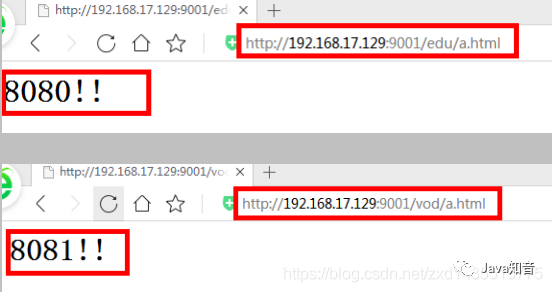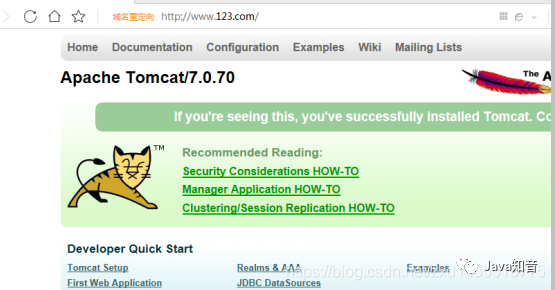Nginx配置反向代理,一篇搞定!
一、引言
其他话不多说,下面来学习一下 Nginx 的反向代理。需要有 Linux 和 Nginx 环境。
二、何为反向代理?
在介绍反向代理之前,先来了解一下正向代理。
正向代理: 如果把局域网外的 Internet 想象成一个巨大的资源库,则局域网中的客户端要访问 Internet,则需要通过代理服务器来访问,这种代理服务就称为正向代理。下面是正向代理的原理图。
由于工作环境原因,日常工作只能局限于单位的局域网,如果想要访问互联网,怎么办呢?这就需要用到正向代理。本人经常用正向代理来进行上网。


这里有个问题:反向代理服务器,怎么选择挂在它后面的哪一台具体服务器呢?答案在后文揭晓,这就是负载均衡。
三、Nginx配置文件
在学习 Nginx 之前,我们要熟知它的配置文件。毕竟,我们下面需要做的所有配置(反向代理、负载均衡、动静分离等),都是基于它的配置文件。
Nginx 默认的配置文件是在安装目录下的 conf 目录下,后续对 Nginx 的使用基本上都是对此配置文件进行相应的修改。完整的配置文件,可以看一下文章最后。修改过nginx.conf配置文件,记得要重启Nginx服务(☆☆☆☆☆)
配置文件中有很多#号,该符号表示注释内容,去掉所有以 # 开头的段落,精简之后的配置文件内容如下(PS:其实注释掉的地方,都是一些功能的使用代码,需要用到的时候,取消注释即可):
worker_processes 1;
events {
worker_connections 1024;
}
http {
include mime.types;
default_type application/octet-stream;
sendfile on;
keepalive_timeout 65;
server {
listen 80;
server_name localhost;
location / {
root html;
index index.html index.htm;
}
error_page 500 502 503 504 /50x.html;
location = /50x.html {
root html;
}
}去掉注释信息后,可以将 nginx.conf 配置文件分为三部分:
第一部分:全局块
worker_processes 1;
从配置文件开始到 events 块之间的内容,主要会设置一些影响 Nginx 服务器整体运行的配置指令,主要包括:配置运行 Nginx 服务器的用户(组)、允许生成的 worker process 数,进程 PID 存放路径、日志存放路径和类型以及配置文件的引入等。
上面这行 worker_processes 配置,这是 Nginx 服务器并发处理服务的关键配置,该值越大,可以支持的并发处理量也越多,但是会受到硬件、软件等设备的制约。
第二部分:events 块
events {
worker_connections 1024;
}events 块涉及的指令主要影响 Nginx 服务器与用户的网络连接,常用的设置包括:是否开启对多 work process下的网络连接进行序列化,是否允许同时接收多个网络连接,选取哪种事件驱动模型来处理连接请求,每个 wordprocess 可以同时支持的最大连接数等。
上述例子就表示每个 work process 支持的最大连接数为 1024。这部分的配置对 Nginx 的性能影响较大,在实际中应该灵活配置。
第三部分:http 块
http {
include mime.types;
default_type application/octet-stream;
sendfile on;
keepalive_timeout 65;
server {
listen 80;
server_name localhost;
location / {
root html;
index index.html index.htm;
}
error_page 500 502 503 504 /50x.html;
location = /50x.html {
root html;
}
}这部分是 Nginx 服务器配置中最频繁的部分,代理、缓存和日志定义等绝大多数功能和第三方模块的配置都在这里。需要注意的是:http 块也可以包括 http 全局块、server 块。下面的反向代理、动静分离、负载均衡都是在这部分中配置
①、http 全局块
http 全局块配置的指令包括:文件引入、MIME-TYPE 定义、日志自定义、连接超时时间、单链接请求数上限等。
②、server 块
这块和虚拟主机有密切关系,虚拟主机从用户角度看,和一台独立的硬件主机是完全一样的,该技术的产生是为了节省互联网服务器硬件成本。
每个 http 块可以包括多个 server 块,而每个 server 块就相当于一个虚拟主机。而每个 server 块也分为全局 server 块,以及可以同时包含多个 locaton 块。(☆☆☆☆☆)
1、全局 server 块
最常见的配置是本虚拟机主机的监听配置和本虚拟主机的名称或 IP 配置。
2、location 块
一个 server 块可以配置多个 location 块。
这块的主要作用是基于 Nginx 服务器接收到的请求字符串(例如 server_name/uri-string),对虚拟主机名称(也可以是 IP 别名)之外的字符串(例如 前面的 /uri-string)进行匹配,对特定的请求进行处理。地址定向、数据缓存和应答控制等功能,还有许多第三方模块的配置也在这里进行。
四、反向代理如何配置
1、反向代理实例一
实现效果:使用 Nginx 反向代理,访问 www.123.com 直接跳转到 127.0.0.1:8080。
注意:此处如果要想从www.123.com跳转到本机指定的ip,需要修改本机的hosts文件。此处略过
配置代码
server {
listen 80;
server_name 192.168.17.129;
location / {
root html;
index index.html index.htm;
proxy_pass http://127.0.0.1:8080
}
}如上配置,我们监听 80 端口,访问域名为 www.123.com(不加端口号时默认为 80 端口),故访问该域名时会跳转到 127.0.0.1:8080 路径上。
此处的意思为:nginx 反向代理服务监听 192.168.17.129的80端口,如果有请求过来,则转到proxy_pass配置的对应服务器上,仅此而已。
实验结果:
2、反向代理实例二
实现效果:使用 Nginx 反向代理,根据访问的路径跳转到不同端口的服务中,Nginx 监听端口为 9001。
- 访问 http://127.0.0.1:9001/edu/ 直接跳转到 127.0.0.1:8081
- 访问 http://127.0.0.1:9001/vod/ 直接跳转到 127.0.0.1:8082
第一步,需要准备两个 tomcat,一个 8001 端口,一个 8002 端口,并准备好测试的页面
第二步,修改 nginx 的配置文件,在 http 块中配置 server
server {
listen 9001;
server_name 192.168.17.129;
location ~ /edu/ {
proxy_pass http://127.0.0.1:8080
}
location ~ /vod/ {
proxy_pass http://127.0.0.1:8081
}
}根据上面的配置,当请求到达 Nginx 反向代理服务器时,会根据请求进行分发到不同的服务上。
实验结果:

该指令用于匹配 URL, 语法如下:
location [ = | ~ | ~* | ^~] uri {
}=:用于不含正则表达式的 uri 前,要求请求字符串与 uri 严格匹配, 如果匹配成功,就停止继续向下搜索并立即处理该请求。~:用于表示 uri 包含正则表达式,并且区分大小写。~*:用于表示 uri 包含正则表达式,并且不区分大小写。^~:用于不含正则表达式的 uri 前,要求 Nginx 服务器找到标识 uri 和请求
字符串匹配度最高的 location 后,立即使用此 location 处理请求,而不再使用 location块中的正则 uri 和请求字符串做匹配。
注意:如果 uri 包含正则表达式,则必须要有 ~ 或者 ~* 标识
Nginx完整配置文件
#user nobody;
worker_processes 1;
#error_log logs/error.log;
#error_log logs/error.log notice;
#error_log logs/error.log info;
#pid logs/nginx.pid;
events {
worker_connections 1024;
}
http {
include mime.types;
default_type application/octet-stream;
#log_format main '$remote_addr - $remote_user [$time_local] "$request" '
# '$status $body_bytes_sent "$http_referer" '
# '"$http_user_agent" "$http_x_forwarded_for"';
#access_log logs/access.log main;
sendfile on;
#tcp_nopush on;
#keepalive_timeout 0;
keepalive_timeout 65;
#gzip on;
server {
listen 80;
server_name localhost;
#charset koi8-r;
#access_log logs/host.access.log main;
location / {
root html;
index index.html index.htm;
}
#error_page 404 /404.html;
# redirect server error pages to the static page /50x.html
#
error_page 500 502 503 504 /50x.html;
location = /50x.html {
root html;
}
# proxy the PHP scripts to Apache listening on 127.0.0.1:80
#
#location ~ \.php$ {
# proxy_pass http://127.0.0.1;
#}
# pass the PHP scripts to FastCGI server listening on 127.0.0.1:9000
#
#location ~ \.php$ {
# root html;
# fastcgi_pass 127.0.0.1:9000;
# fastcgi_index index.php;
# fastcgi_param SCRIPT_FILENAME /scripts$fastcgi_script_name;
# include fastcgi_params;
#}
# deny access to .htaccess files, if Apache's document root
# concurs with nginx's one
#
#location ~ /\.ht {
# deny all;
#}
}
# another virtual host using mix of IP-, name-, and port-based configuration
#
#server {
# listen 8000;
# listen somename:8080;
# server_name somename alias another.alias;
# location / {
# root html;
# index index.html index.htm;
# }
#}
# HTTPS server
#
#server {
# listen 443 ssl;
# server_name localhost;
# ssl_certificate cert.pem;
# ssl_certificate_key cert.key;
# ssl_session_cache shared:SSL:1m;
# ssl_session_timeout 5m;
# ssl_ciphers HIGH:!aNULL:!MD5;
# ssl_prefer_server_ciphers on;
# location / {
# root html;
# index index.html index.htm;
# }
#}
}